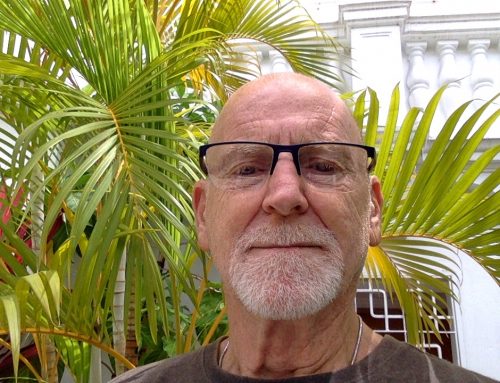When I was in high school, I would wear a bow in my hair every day. It became my signature. People in my community knew me as the happy girl with the bow.
I was bow girl.
When I was seventeen, my depressive symptoms arrived. I felt miserable and I didn’t know why. I didn’t want to talk to people. I lacked motivation to do anything. The thoughts in my head terrified me and I struggled with almost all the emotions I felt and the thoughts I had.
But most of all, I didn’t know how to NOT be the happy girl with the bow.
I had built an image for myself.
I didn’t know who I was apart from that.
So every day, I put that bow on and pretended everything was okay. That I was happy. That I wasn’t battling this monster inside me that I had no name for. A monster I would soon learn was not going away and would only grow stronger when I ignored its existence. When the bow went on, I faked every interaction I had. I smiled brightly, I laughed, I gave hugs with enthusiasm.
And it was all a lie.
I was dying inside and no one knew.
I tried to be me, or at least the me that I thought I was and the person people expected to see.
But I didn’t realize the definition of me was changing.
Those ribbons started to strangle me.
……….
I moved away to go to college and the darkness didn’t go away. It got worse.
I couldn’t convince myself to leave my bed to go to school in the morning. When people asked me about missing class, I would say that I was sick or my class got cancelled. How do you say “I couldn’t get out of bed because my brain is a dark, dead place so I spent the morning thinking about dying instead” to people you just met when everyone is trying to build their college circle of friends? I just moved to a new city, to a new school, and I didn’t know anyone.
I needed to be liked to survive.
And I needed to be Bow Girl to be liked.
My depressive symptoms kept getting worse. I would ping-pong between not eating enough to eating too much. I started having a hard time sleeping, which eventually developed into insomnia and night terrors. I exercised way too much. I felt perpetually empty, void of everything that had formerly composed me. I became a shell of a person. There was nothing left in me- no drive, no passion, no vision. I would sit in my shower for hours trying to cry- trying to feel anything. I wondered why my therapist told me I had depression because I didn’t feel sad- I felt absolutely nothing.
That deadness was far worse than sadness.
I don’t know what would have happened to me if I hadn’t finally found inspiration:
The human brain.
…….
I’d never learned anything about neuroscience until college. When I took my first neuro class though, I felt a jolt of life that I had not experienced in months. In the same way the darkness had overcome me, slowly I was beginning to see how passion could captivate me too.
The brain is utter poetry. It is a space that should be chaotic but somehow has been controlled. It is a series of movements & mechanisms that are responsible for everything we are.
It is beautiful.
But sometimes, it betrays us.
That is what mental illness looks like.
When I learned the neurological basis of the major mental illnesses, it hit me in a very real way that mental illness is not a choice. It is not a life path people have chosen, It is not a wound that time will heal. It is a chronic illness that takes a lot of work to overcome.
I started feeling very defensive when watching certain movies or tv shows that depicted mental health issues as laughable, or just dubbing people as “crazy.” Now, I had the education to understand what mental illness is and perhaps more importantly, what it is not.
Neuroscience inspired my life’s goal:
I wanted to be part of the movement to eliminate the stigma of mental illness.
Then it hit me. I am perpetuating the very thing I want to fight against.
Destigmatization need to happen across the planet.
But first, it needs to start with me.
How I view my depression diagnosis and how I present myself to the world.
So now, I’m in the undoing.
My life has become a process of taking that bow off and throwing it away. This isn’t something you do once and it’s over. No, I choose everyday whether to put that bow on or keep it off.
I talked to my therapist about the Bow Girl phenomenon. She brilliantly replied, “Instead of showing that you’re a person of perseverance, you want to show that you’re a person of perfection.”
One sentence and she gave me enough to ponder until my next session.
It was more than that, though; she gave me a tool to change my life forever.
I learned that being a person of perseverance is far more valuable than striving for perfection. Perseverance is real life. It is relatable. It is who I actually am. It is looking back at everything i’ve overcome and saying I can do hard things.
I had to make a decision to believe having that is more valuable that looking like I have it all together.
Now I know I don’t need to be Bow Girl to be liked.
I just need to be honest.
And now my life is a series of choices to be honest— honest with myself and honest with people.
I don’t know where you are at in your journey— maybe you’re a lot farther along than me or maybe you’re just now understanding that you
Regardless of where you are at, remind yourself of this one thing as I do throughout my day: This is not your fault & you are worthy of love. You do not need to be perfect, you just need to persevere. And most of all, you have nothing to be ashamed of.
 Alexis Zevnick is a mental health activist from the Pacific Northwest. She earned a Bachelor of Arts in Psychology at the University of Washington. Her life’s work is centered around eliminating the stigma of mental illness and promoting positive mental wellness. Currently, Alexis is pursuing a Master’s degree at Northwestern University studying mental health counseling.
Alexis Zevnick is a mental health activist from the Pacific Northwest. She earned a Bachelor of Arts in Psychology at the University of Washington. Her life’s work is centered around eliminating the stigma of mental illness and promoting positive mental wellness. Currently, Alexis is pursuing a Master’s degree at Northwestern University studying mental health counseling.
Alexis can be found on her blog.








the link to her blog doesn’t work… 🙁
It should work now 🙂 Sorry about that!